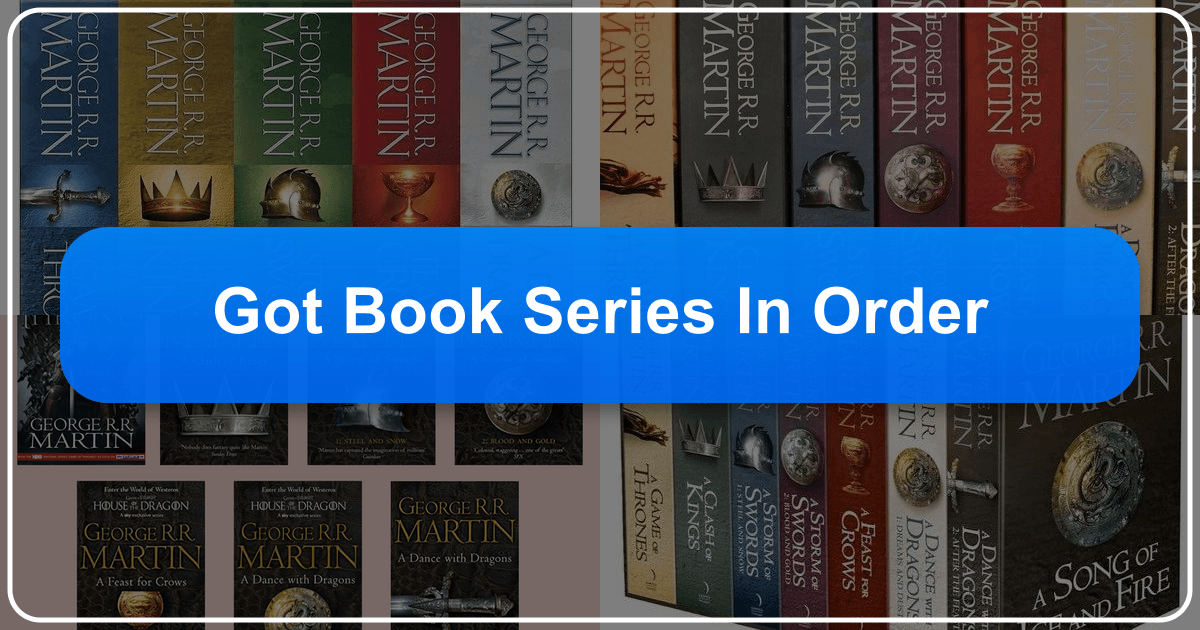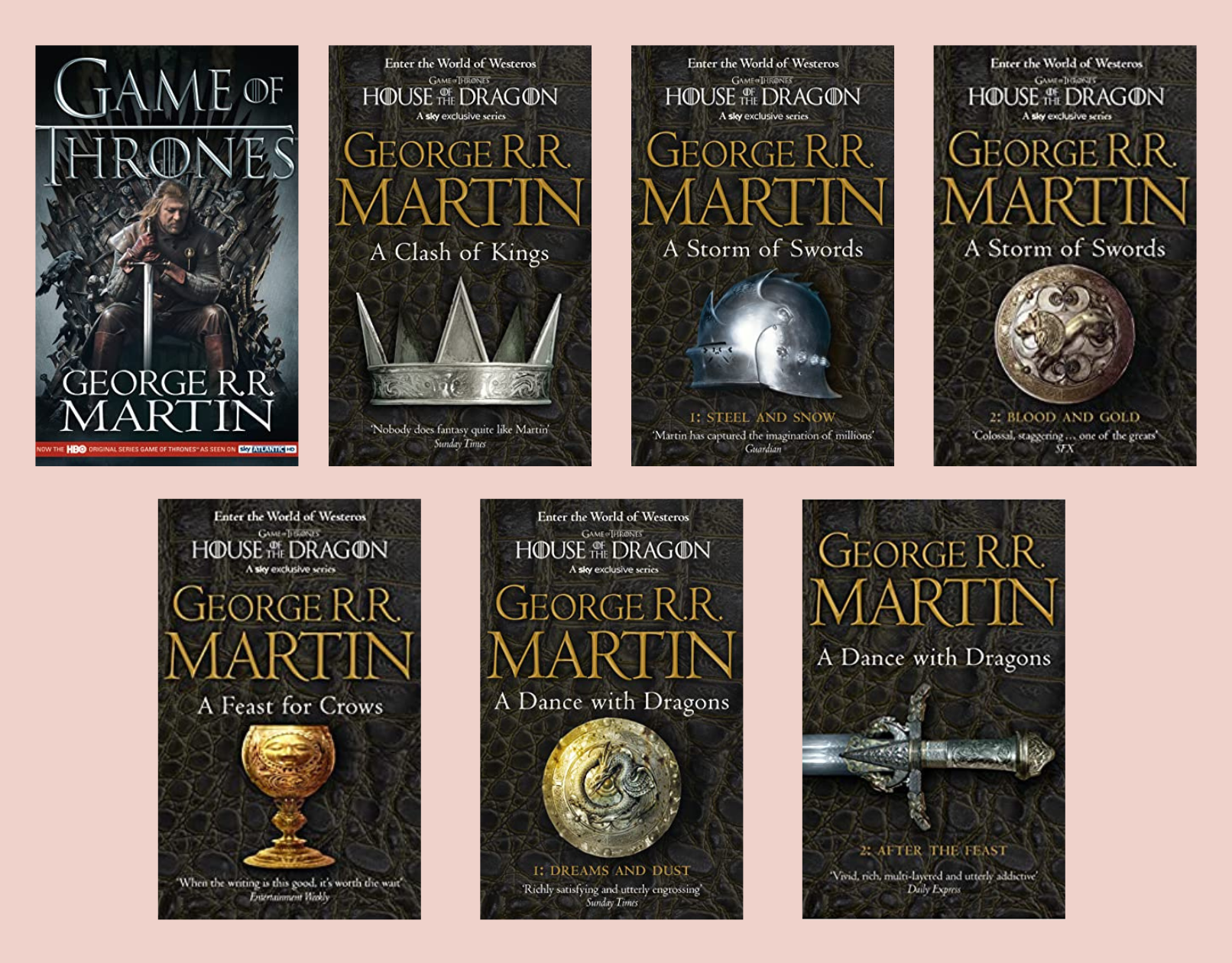Game of Thrones Books in Order: A Comprehensive Guide

The Game of Thrones series, based on George R.R. Martin’s A Song of Ice and Fire novels, has captivated audiences worldwide. While the HBO adaptation brought the story to a global audience, the books offer a deeper, richer experience. This comprehensive guide explores the Game of Thrones book series, examining its chronological order, release order, plot summaries, character development, and cultural impact. We’ll delve into the main novels, prequels, and companion books, highlighting key differences between the books and the television series.
A Song of Ice and Fire: The Main Series
George R.R. Martin’s A Song of Ice and Fire saga is a sprawling epic fantasy series, currently comprising five completed novels and two planned but not yet released books. The following is a breakdown of the published novels in both chronological and release order, providing detailed plot summaries to help readers appreciate the narrative arc.
A Song of Ice and Fire in Chronological Order

Reading the books chronologically offers a more cohesive understanding of the series’ complex timeline and interwoven storylines.
-
Fire and Blood (2018): This companion book serves as a history of House Targaryen, spanning three hundred years before the events of A Game of Thrones. It’s the primary source material for HBO’s House of the Dragon, providing context for the prequel series. The book traces the Targaryen’s rise to power, their internal conflicts, and their eventual decline. It introduces pivotal characters and significant events that shaped the world of Westeros, making it essential reading for a comprehensive understanding of the wider ASOIAF universe.
-
A Knight of the Seven Kingdoms (2015): Set a century before A Game of Thrones, this collection of novellas follows the adventures of Ser Duncan the Tall, a hedge knight, and his squire Egg (who is secretly Aegon V Targaryen). These stories provide fascinating glimpses into the Targaryen dynasty’s past, revealing lesser-known aspects of their history and offering valuable insight into the lineage and character of future Targaryens, further enriching the overall narrative.

- A Game of Thrones (1996): The saga begins here, introducing the central characters and the primary conflict for control of the Iron Throne following the death of King Robert Baratheon. We are immersed in the world of Westeros, witnessing the machinations of the noble houses, including the Starks, Lannisters, and Targaryens. The seeds of conflict are sown, as alliances are formed and broken, and power struggles escalate. This initial volume lays the groundwork for the larger narrative, showcasing Martin’s exceptional world-building and character development.

-
A Clash of Kings (1998): The War of the Five Kings erupts, with various factions vying for the Iron Throne. Robb Stark, Stannis Baratheon, Renly Baratheon, Joffrey Baratheon, and Balon Greyjoy all make claims to power. Daenerys Targaryen continues her journey in Essos, further developing her power and confronting challenges along the way. This volume expands upon the political intrigue and introduces new characters, complicating the already tense situation.
-
A Storm of Swords (2000): This volume is arguably the most impactful, filled with dramatic events and pivotal turning points in the saga. The Red Wedding, a shocking massacre, decimates Robb Stark’s forces. Joffrey Baratheon’s death at the Purple Wedding introduces a new element of chaos. Tyrion Lannister’s trial and escape add complexity to the plot. This pivotal installment is characterized by unexpected deaths and significant shifts in the political landscape of Westeros, leaving readers stunned and breathless.
-
A Feast for Crows (2005): Following the devastation of A Storm of Swords, A Feast for Crows shifts focus to the aftermath of the war. This installment is known for its shift in narrative perspective, which some found unexpected. The remaining characters confront the consequences of past actions. The political landscape is shifting, and new threats emerge, while others consolidate power. This entry focuses on multiple narratives running concurrently, creating a complex and multifaceted storyline.
-
A Dance with Dragons (2011): This novel continues the story from multiple perspectives in both Westeros and Essos. The wildling threat grows, leading to conflict at the Wall. Daenerys Targaryen faces mounting problems in Mereen. Tyrion Lannister’s journey takes him to Essos, where he becomes embroiled in the complex politics of the region. The revelation of a still-living Aegon Targaryen sets up a final conflict for the Iron Throne. This is where the series narrative greatly diverges from the HBO series.
-
The Winds of Winter (Forthcoming): The sixth book in the series is still being written.
-
A Dream of Spring (Forthcoming): This will be the final installment of the series, completing the saga’s narrative.
A Song of Ice and Fire in Release Order
The release order mirrors the historical publication dates of the books:
- A Game of Thrones (1996)
- A Clash of Kings (1998)
- A Storm of Swords (2000)
- A Feast for Crows (2005)
- A Dance with Dragons (2011)
- The Winds of Winter (Forthcoming)
- A Dream of Spring (Forthcoming)
Beyond the Main Series: Prequels and Companion Books
Martin has expanded the A Song of Ice and Fire universe with several prequels and companion books.
Fire and Blood (2018)
As discussed previously, Fire and Blood provides a detailed history of House Targaryen, setting the stage for House of the Dragon.
Tales of Dunk and Egg
This series of novellas offers a more concise narrative and a different reading experience within the ASOIAF universe. The stories are shorter and focus on Ser Duncan the Tall and his squire Egg. These stories, while not central to the main plot, provide significant background information that illuminates various aspects of the main series.
- The Hedge Knight (1998)
- The Sworn Sword (2003)
- The Mystery Knight (2010)
- Further Novellas (Forthcoming)
Cultural Impact and Adaptations
The Game of Thrones books have had a profound cultural impact, influencing fantasy literature and inspiring various adaptations. The HBO television series, while initially faithful to the source material, gradually diverged in later seasons, leading to significant differences in plot points and character arcs. This divergence has sparked much discussion amongst fans, highlighting the power of the source material. The books offer a complex narrative, detailed character development, and intricate world-building that sets them apart. The books’ popularity led to the creation of the prequel series House of the Dragon, further proving the enduring appeal of Martin’s creation. The overall cultural influence extends beyond television, impacting various media including video games, merchandise, and other literary works.
Conclusion
George R.R. Martin’s A Song of Ice and Fire is a monumental work of epic fantasy. While the television series offered a broad introduction to the world of Westeros, the books provide a significantly deeper and more nuanced exploration of the characters, plots, and the world itself. Whether read chronologically or in release order, the Game of Thrones books are a rich and rewarding experience for readers seeking intricate storytelling, political intrigue, and memorable characters. The eagerly awaited conclusion of the series promises to be one of the most significant events in contemporary fantasy literature. This guide serves only as an introduction – Lbibinders.org offers numerous resources for further exploration and engagement with this complex and richly rewarding series.